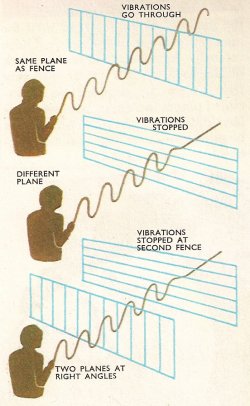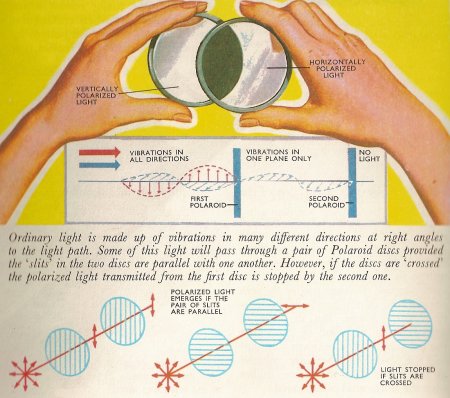polarization

The vibrations in the rope will only pass through the narrow gap in the railings if the vibrations are parallel to the individual rails. Thus an up and down vibration is transmitted through the vertical railings, but is stopped by the horizontal ones.

Polaroid disks.
Polarization is a condition in which electromagnetic waves are constrained to vibrate in a certain plane or planes (see polarized light). Electromagnetic waves consist of vibrating electric and magnetic fields, with the direction of vibration perpendicular to the direction of motion of the wave. If the direction of vibration remains steady with time, the wave is said to be 100% linearly polarized or plane polarized in that direction. If the direction of vibration rotates at the same frequency as the wave, the wave is said to be 100% circularly polarized. Most naturally occurring electromagnetic waves have a direction of vibration that jiggles around at random: these are said to be unpolarized. Intermediate states, where there is some jiggling around an average direction, are said to be partially polarized; the amount of order is specified by the degree of polarization, which ranges from 0 to 100%. Plane polarization is usually caused by scattering, and circular polarization by strong magnetic fields.
Polarization explained
Light is a form of wave motion, but as it travels at such a high speed (300,000 kilometers per second) it isn't possible to observe directly the way in which the moving waves vibrate. However, experiments show that the waves vibrate at right angles to the direction of the light beam, and because of this light is said to consist of transverse waves.
Since the vibration of light waves can't be seen, it's useful to see how other visible transverse waves vibrate. Such waves may be set up in a length of rope by repeatedly moving one end up and down (i.e. at right angles to the rope). The vibrations in the rope will pass through a narrow gap provided the longest axis of the gap is parallel to the direction of the vibrations. Thus if the rope is vibrating up and down, the motion will be transmitted through a vertical gap. However, if the rope also passes through a horizontal gap the vibrations can't pass through this.
The rope in this example can only vibrate in one plane (at right angles to the direction of travel). But an ordinary beam of light consists of a great number of individual waves which are vibrating in different directions (all at right angles to the light path). But under certain conditions it is possible for all the vibrations in a light beam to be confined to one plane are right angles to the beam. Such a beam is said to be polarized.
Crystals that polarize
Certain crystals, in particular transparent crystals of calcite (a form of calcium carbonate) known as Iceland spar, have the property of polarizing light. The ability of such crystals to polarize light can be tested by passing a ray of light through two crystals of the substance. Each crystal can be thought of as containing a number of very narrow slits parallel to each other. These "slits" are so narrow that only the waves whose vibrations are parallel to the slits can pass through.
Thus the light emerging from the first crystal is made up of waves whose vibrations are almost parallel with one another. The passage of light whose plane of polarization does not correspond with the favored plane is stopped. If the second crystal is arranged so that the 'slits' are parallel with those in the first crystal the polarized light leaving the first crystal will pass through the second crystal also. But if the second crystal is then rotated, the amount of light transmitted will be reduced until a point will be reached (at right angles to the first position) when no light is transmitted through the second crystal. In this position the waves of polarized light are vibrating at right angles to the slits, so the vibrations are unable to pass through it.
Polarization by reflection
Light can be polarized by reflection as well as by refraction. In fact the French physicist E. L. Malus (1775–1812) discovered this property of light after observing sunlight reflected from windows. Malus' discovery can best be illustrated by means of a simple experiment. Two mirrors are arranged parallel to each other, forming a kind of periscope. When one of the mirrors is rotated it is found that the amount of light reflected from the second mirror gradually decreases to a minimum (it disappears completely in one position – but this is very difficult to attain) and then increases again. What is happening is that on reflection at the first mirror the vibrations in all but one plane are absorbed. In other words, the reflected beam is polarized. How completely the light is polarized depends on the angle of incidence. As the proportion of light reflected from a surface is quite small, this is not a very effective method of obtaining polarized light, so light is usually polarized by refraction.
Polaroid
One quite satisfactory polarizing medium has been manufactured and is marketed under the Polaroid trade name. It comprises a cellulose nitrate film containing very small crystals of iodoquinine sulfate. In manufacture, these tiny crystals are made to line themselves up in one direction so that they behave like crystals of Iceland spar.
Polaroid disks can be used to produce polarized light in much the same way as with other polarizing media. If ordinary light enters the film, the light emerging is polarized – almost all vibrations are right angles to the favored direction have been absorbed. That the light has been polarized can be shown by rotating a second Polaroid disk in the path of the light emerging from the first. As the second disk is rotated a point is reached at which where virtually no light is transmitted – the greatest amount of light is transmitted when the disk is at right angles to this position. Polaroid has many uses, not the least of which is sun glasses. With these the glare caused by the sun's light being reflected from the road or water surfaces, etc., is considerably reduced. The reflected light is already polarized so that only that portion of the light which is polarized in the favored direction is transmitted through the Polaroid disk.
Optical activity and the polarimeter
Solutions of various sugars, including cane sugar (sucrose) and of certain other organic substances have the property of rotating the plane of polarization of light passed through them. The extent of the rotation is measured with an apparatus called a polarimeter or saccharimeter. This comprises a source of monochromatic light – usually a sodium lamp, a means of polarizing the light (a polarizer), a tube to hold the sample, and a means of checking the plane of polarization (an analyzer).
To use the apparatus the tube is first filled with water, the lamp switched on and the analyzer rotated until no light is seen to emerge from it. The polarizer and analyzer are then said to be crossed. The water in the tube is then replaced by the solution under test. The analyzer is again rotated until it is again crossed, and the angle through which the plane of polarization has been rotated is then noted. Some substances (e.g. d-glucose) cause the plane of polarization to rotate in a clockwise or right-handed sense. These are said to be dextrorotatory. By contrast, levorotatory substances (e.g. l-fructose) cause the plane of polarization to be rotated in an anticlockwise or left-handed sense. Such information provides clues to the structure of these compounds. The amount of rotation indicates the strength of the solution.


